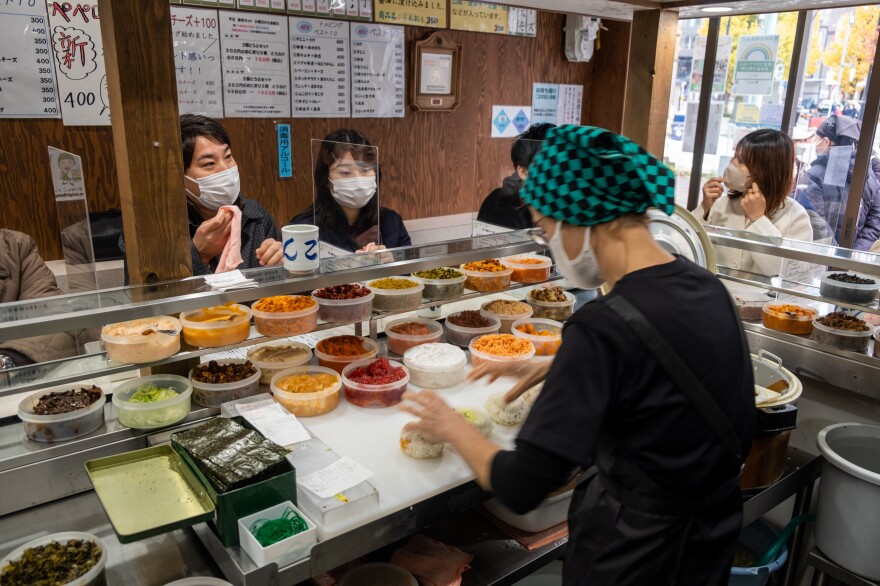TOKYO — The world's great cuisines can regale the eye and the palate. Or, alternatively, they may celebrate the plain and exalt the humble — for example, by recreating home-style comfort food in a restaurant setting.
A popular and compact eatery in Tokyo's Toshima ward, called Onigiri Bongo, does just that. It has served one of Japan's most humble foods, the onigiri, or rice ball, for some 60 years.
Diners at Onigiri Bongo — named for the drum, whose sound resonates far and wide like the restaurant's reputation — are squeezed into nine seats around an L-shaped counter. Its tiny space, and its reputation as one of the city's top onigiri emporia, produces lines of customers stretching down the street, waiting for three or four hours, or more.


Behind the counter is the restaurant's wiry and sprightly owner, 70-year-old Yumiko Ukon. She scoops rice from a huge pot, putting it in triangular molds and packing them with a variety of fillings — more than 50, including standards such as bonito or salmon flake, pickled plum, mustard greens and cod roe, and innovations such as pork and kimchi, and fried chicken with mayonnaise and soy sauce.
Then she puts more rice on the top, and deftly shapes them with three final squeezes. She wraps each rice ball in a thin sheet of seaweed and serves them to customers at the counter. The restaurant serves between 1,200 and 1,500 onigiri every day.

Japanese people have been eating onigiri for 2,000 years
The onigiri is sometimes born of the leftovers of family rice pots, and often packed in school and travel lunchboxes and hiking and picnic bags. Packaged, commercial versions of onigiri line the shelves of convenience stores across Japan.
Archaeological evidence from Japan's Yayoi period (roughly 300 B.C.E. to 250 C.E.) seems to suggest that Japanese have been eating variations of onigiri for more than 2,000 years. The rice balls are known by different names, depending on the era and region. The word onigiri itself comes from the Japanese word "nigiru," to squeeze, referring to how the rice ball is shaped by hand.

Bongo Onigiri's main ingredients are sourced from around the country, including short-grain Koshihikari rice from terraced paddies of Ukon's native Niigata prefecture, seaweed from Japan's Ariake Sea and salt from Okinawa.
For the current owner, the restaurant was "love at first sight"

At Onigiri Bongo, Ukon's gentle squeezes leave the rice balls fluffy and crumbly. The onigiri are sizable, the rice a bit al dente, and the tastes simple, genuine and straight-up scrumptious. The rice balls are often served in a set, including pickles and miso soup. A weekday meal set with two onigiri and tofu soup goes for for 800 yen, about $5.98 — in Tokyo, a very affordable lunch.
But to Ukon, what makes onigiri special is not the details of preparation, but their meaning, and the way people bond over them.
"It's not about the technique. It's about how much feeling you can put into each onigiri. That's why I'll never forget my mother's onigiri for the rest of my life," she says.
"It was part of our culture not to buy them, but to make them at home," she recalls.
After she moved to Tokyo at around age 20, "Onigiri were always there in my happy memories, like of athletic festivals or school hikes," says Ukon. "My best memories of onigiri are of the ones my mother made when I came home from Tokyo."

Freshly arrived in the capital, she says she felt like a "food refugee" because "I couldn't find food I liked," she recalls. "But a friend introduced me to a delicious rice ball restaurant, and it was love at first sight."
Ukon was not destined to be just another customer. She married the restaurant's owner, Tasuku Ukon, 27 years her senior. After he passed away in 2012, she took over.
Now, after more than 40 years of running the place, she continues to serve up onigiri with vigor and passion.
"I thought about retiring at 70," she says, "but I'm still in good health, and I want to see the smiling faces of the people eating the rice balls."
Chie Kobayashi contributed to this report in Tokyo.
Copyright 2023 NPR. To see more, visit https://www.npr.org.







